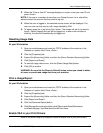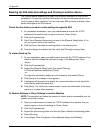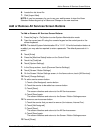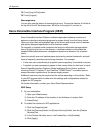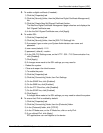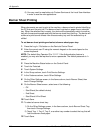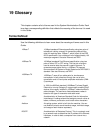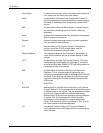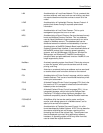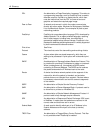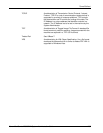
19 Glossary
220 Xerox WorkCentre 7232/7242 System Administration Guide
Client Server A network environment in which the nodes communicate with
a file server, and not directly with other nodes.
DHCP An abbreviation of Dynamic Host Configuration Protocol. A
protocol allowing the principal parameters of network devices
(including IP Addresses) to be configured by central DHCP
servers.
DNS An abbreviation of Domain Name System. A system used in
the Internet for translating names of network nodes into
addresses.
Driver Software that is loaded on the client workstation that prepares
data to be sent to the machine.
Ethernet Network transport technology commonly used to send data
from one network node to another.
FTP An abbreviation of File Transfer Protocol. An application
protocol, part of the TCP/IP protocol stack, used for
transferring files between network nodes.
Gateway Address The Gateway Address is the IP Address of the gateway, or
router, that the machine will use to access devices on other
subnets.
HTTP An abbreviation of Hyper Text Transfer Protocol. This is the
Internet standard that supports the exchange of information
on the World Wide Web (WWW). HTTP lays the foundation for
transparent access to the Internet.
IEEE An abbreviation of Institute of Electrical and Electronics
Engineers. This is an organization of engineering and
electronics professionals notable for developing the IEEE 802
standards for the physical and data-link layers of local area
networks, following the ISO Open Systems Interconnection
(OSI) model.
IP See TCP/IP
IPv4/IPv6 Abbreviations for "Internet Protocol Version 4" and "Internet
Protocol Version 6". IPv4 addresses are 32-bit identifiers used
to address hosts on the Internet. They are expressed in dotted
quad format, a series of decimal numbers separated by
decimal points. IPv6 is the next generation protocol designed
to replace IPv4. IPv6 addresses are 128-bit identifiers
expressed in 16-bit hexadecimal numbers separated by
colons. IPv6 corrects a number of problems in IPv4, such as
the limited number of available addresses.
IPX Internetwork Packet Exchange. IPX is part of NetWare. It
routes packets to the correct node and to the correct process
within the node.



